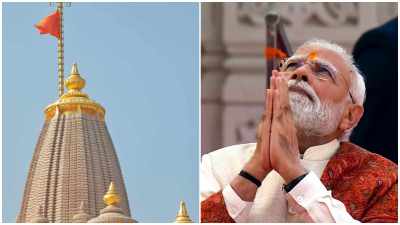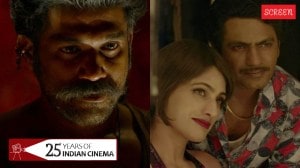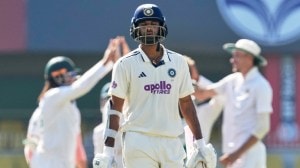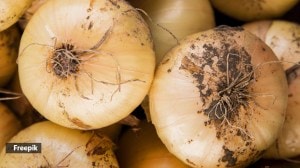Why the Tamil Nadu CM and Governor’s posts on Thiruvalluvar Day sparked a row, again
CM Stalin's post showed the poet in white robes, while Governor RN Ravi shared a depiction of Thiruvalluvar in saffron robes. This is not the first time the issue has divided political figures in Tamil Nadu. Here’s why.
 The posts on Thiruvallavur, shared by Tamil Nadu Governor RN Ravi (left) and Chief Minister MK Stalin on X. (Photos via X.com)
The posts on Thiruvallavur, shared by Tamil Nadu Governor RN Ravi (left) and Chief Minister MK Stalin on X. (Photos via X.com)Marking Thiruvalluvar Day on Tuesday (January 16), Tamil Nadu Governor RN Ravi shared an image of the philosopher-poet in saffron-coloured clothes and described him as “the revered poet, great philosopher and brightest saint of Bharatiya Sanatan tradition”.
The post sparked off a row as the ruling DMK alleged attempts at “saffronisation” by the governor’s office. Ravi’s photo showed Thiruvalluvar’s forehead and upper arm as smeared with ash and prayer beads around his neck. Meanwhile, another post from Tamil Nadu Chief Minister MK Stalin depicted the poet in white robes.
“On #ThiruvalluvarDay, I pay my humble tributes to the revered poet, great philosopher and brightest saint of Bharatiya Sanatan tradition, Thiruvalluvar born on the spiritual land of our Tamil Nadu. His eternal wisdom has immensely shaped and enriched the ideas and identity of… pic.twitter.com/xvccnimWsf
— RAJ BHAVAN, TAMIL NADU (@rajbhavan_tn) January 16, 2024
தமிழினத்தில் பிறந்து அமிழ்தமிழில் அறம் உரைத்து உலகம் முழுமைக்குமான நெறிகள் சொன்ன வான்புகழ் வள்ளுவர் நாள் வாழ்த்துகள்!
பிறப்பொக்கும் எல்லா உயிர்க்கும் என்ற சமூகநீதிக் கோட்பாட்டையும் – முயற்சி மட்டுமே வெற்றியைத் தரும் என்ற தன்னம்பிக்கை ஊக்கத்தையும் – அறன் எனப் பட்டதே இல்வாழ்க்கை… pic.twitter.com/wUuvMJ4q63
— M.K.Stalin (@mkstalin) January 16, 2024
DMK MP Kanimozhi criticised the governor’s post, saying, “There are no religious symbols in Thirukkural, we cannot impose Sanatan or Hindutva symbols or any other religion on Thiruvalluvar. We need to understand this. Thirukkural is something which is beyond religion and speaks humanity.”
This is not the first time the issue of Thiruvallavur’s representation has divided political figures in Tamil Nadu over party lines. Here’s why.
Who was Thiruvallavur?
Thiruvalluvar is a prominent cultural figure in the region. It isn’t easy to pinpoint the period he inhabited, he may have lived in the 5th century BC or earlier. He is fondly referred to as Valluvar by Tamils. His ‘Tirukkural’, a collection of 1,330 couplets (‘kurals’ in Tamil), are an essential part of every Tamil household — in the same way as, say, the Bhagavad Gita or the Ramayana are in traditional North Indian Hindu households.
Thiruvalluvar is revered as an ancient saint, poet, and philosopher by Tamilians, irrespective of their religion. He is an essential anchor for Tamilians in tracing their cultural roots; they are taught to learn his couplets word-for-word and to follow his teachings in their day-to-day life.
While presenting the Budget in 2020, Finance Minister Nirmala Sitharaman quoted him: “Pini Inmai Selvam Vilaivu Inbam Emam Ani Enba”, which loosely translates to having the “five jewels” required for a country that is without illness, with wealth, with good crops, with happiness, as well as safety and security.
Why is the colour of Thiruvalluvar’s robes important?
The poet’s depictions, including his clothes, have been shaped by various political groups over time, despite a lack of historical information on the matter.
S Swaminathan, a retired IIT professor who specialised in ancient Tamil history, earlier told The Indian Express: “From whatever little evidence left on Thiruvalluvur’s life, several scholars had concluded that most likely he was a Jain, neither a Hindu nor a Dravidian. All that we can ascertain is Tirukkural, his extraordinary piece of literature, has no comparison in Indian history or ancient literature.”
He added, “The so-called picture of Thiruvalluvar in white robes itself was a recent imagination. No figure or picture of Thiruvalluvar existed [earlier]. We do not even know whether the ancient saint who penned Tirukkural was one person or a blend of many over the years. Like Jesus, we created the figure of Thiruvalluvar several hundred years after his death.”
Then BJP national secretary H Raja told The Indian Express in 2019 that Dravidian parties who don’t believe in gods had removed Hindu symbols from depictions of Thiruvalluvar. “The original Thiruvalluvar had vibhuti and all Hindu symbols. It was Dravida Kazhagam and DMK who changed his appearance to suit their political ends,” he said, arguing that the saint’s verses and life were similar to Sanatan Dharma.
Regarding the governor’s post, DMK MP Kanimozhi said the post reflects a lack of basic understanding of Thiruvalluvar or Thirukkural.“No one has said Thiruvalluvar is a saint, there is a notion that he was married and no one has written so beautifully and poetically about domestic life than him. Us, Tamils, who had the opportunity to read and understand Thirukkural never saw him as a saint,” she told the media in Chennai.
What makes Thiruvalluvar significant today?
Following the recent excavations at Keeladi near Madurai, the Tamil Nadu state archaeological department has unearthed evidence that pushes back the history of the Sangam Era, or Tamilagam, by at least 300 years — from 300 BC to 600 BC. The findings at Keeladi have given Dravidian historians and politicians another weapon to assert their ancient past.
The controversy on the alleged saffronisation of Thiruvallauvar has happened in this context. Keeladi had triggered heated arguments on social media between the supporters of Hindutva, and those backing the Dravidian view. While samples from Keeladi did not unearth any Hindu idols or goddesses — a fact that gave Dravidian groups a shot in the arm — Hindutva supporters on social media were seen insisting that there was evidence of ‘Hindu’ religion in Keeladi.
Other instances
Differences in depictions have led to rows in the past in Tamil Nadu. During a book festival in July 2022 in Coimbatore, participants were provided with a copy of the classic Thirukkural featuring a picture of Thiruvalluvar clad in saffron.
In 2021, Tamil Nadu Agricultural University (TNAU) in Coimbatore found itself at the centre of a row after a portrait of Thiruvalluvar in a saffron robe was placed in its library. Later, it was replaced with Thiruvalluvar’s portrait in white attire.
In 2019, the BJP state unit in Tamil Nadu tweeted a picture of Thiruvalluvar wearing saffron robes, leading to protests from the Dravidian and Left parties.
Back in 2017, a similar controversy was created when the BJP called the 19th-century social reformer Sree Narayana Guru a Hindu saint. Guru, who is credited with laying the foundations for Kerala’s social and secular fabric, is known for opposing casteism and promoting spiritual freedom.



- 01
- 02
- 03
- 04
- 05



































